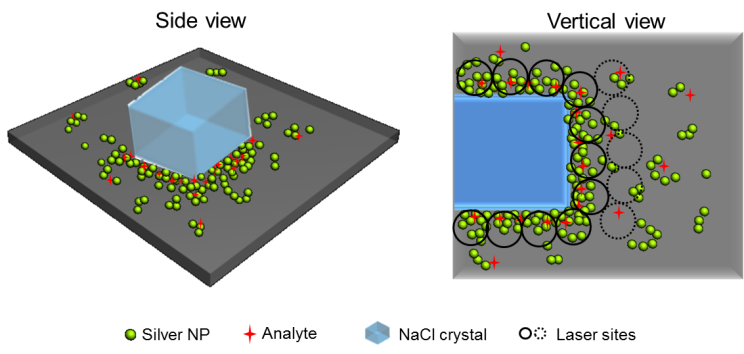
In the paper published in Chemistry - A European Journal, the study team led by Prof. YANG Liangbao from Institute of Intelligent Machines, Hefei Institutes of Physical Science proposed a novel sodium chloride crystal-induced surface enhanced raman scattering (SERS) platform that owns locations and trapping of illicit drugs for highly sensitive detection.
Aggregation of metal colloids is perhaps the simplest method to produce substrates that can exhibit field enhancements large enough for SERS detection.
However, the aggregation of colloids is unstable as it gradually becomes so large that it cannot survive in solution. Moreover, laser focus is easily disturbed by the environment under solution-phase and water or the other liquids between objective lens and SERS substrates would attenuate the collected SERS signal sharply.
In this work, unlike conventional solution-phase SERS detection methods, researchers have demonstrated a practical approach that sodium chloride crystal induced SERS platform for controlled highly sensitive detection of illicit drugs, which was schematically shown from side and vertical view.
During the process of solvent volatilization, NaCl crystals gradually appeared to assemble the silver aggregates around themselves and analytes can be trapped in the presence of capillary force.
Moreover, the micro-scale crystals state can act as the template to obtain optical position, so that the assembled hot areas are conventionally located during SERS measurements to get the reproducible SERS signals and eliminate the need for mapping large areas to get the SERS signals of analytes.
In addition, the chlorine ions can also replace the substances coated on the surface of the silver sol, and further restrained the background signals. Using the novel method, high quality SERS spectra from heroin, methamphetamine (MAMP) and cocaine can be obtained.
This approach not only easily brings the NPs to form plasmonic hot spots, but also provides effective locations, and this assembled SERS nanostructures can potentially be explored as active substrate for label-free illicit drugs or additives detection.
The authors acknowledge the financial support from the Sci-tech Police Project of Anhui Province, the National Science Foundation of China; Special Financial Grant from the China Postdoctoral Science Foundation, and Anhui Natural Science Foundation.

Schematic illustration of NaCl crystal-induced SERS platform and the distribution of the effective spots of laser sites (Image by YU Borong)

86-10-68597521 (day)
86-10-68597289 (night)

52 Sanlihe Rd., Xicheng District,
Beijing, China (100864)

